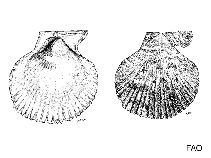Mizuhopecten yessoensis (Jay, 1857)
Large weathervane scallop| Native range | All suitable habitat | Point map | Year 2050 |

|
| This map was computer-generated and has not yet been reviewed. |
| Mizuhopecten yessoensis AquaMaps Data sources: GBIF OBIS |
تصوير گوگل | No image available for this species;
drawing shows typical species in Pectinidae.
رده بندی / Names اسامي عام | مترادف | CoL | ITIS | WoRMS
Bivalvia | Pectinida | Pectinidae
Environment: milieu / climate zone / تغييرات عمق / distribution range بوم شناسي
; تغييرات عمق 0 - 100 m (مرجع 356), usually 2 - 80 m (مرجع 75831). Temperate, preferred 17°C (مرجع 107945); 56°N - 35°N, 127°E - 151°E
Distribution كشورها | مناطق سازمان خوار و بار جهاني (FAO) | Ecosystems | ظهور | معرفي
Northwest Pacific: from the Sea of Japan (North and South Korea and Russia) to Pacific coast of Japan (35°N) to the Sea of Okhotsk, southern Sakhalin and southern Kuril Islands. Introduced in Northeast Atlantic and the Mediterranean.
Length at first maturity / Size / Weight / سن
بلوغ: Lm ? range ? - ? cm Max length : 25.0 cm SHL جنس نر / بدون خواص جنسي; (مرجع )
Life cycle and mating behavior بلوغ | تولید مثل | تخم ریزی | Eggs | Fecundity | Larvae
مآخذ اصلی
مراجع | هماهنگ كننده | همكاران
SAUP Database 2006 SAUP Database. www.seaaroundus.org. (مرجع 356)
وضعيت در فهرست قرمز IUCN
(مرجع 130435: Version 2025-1)
وضعيت از نظر سايتس (مرجع 108899)
CMS (مرجع 116361)
خطر برای انسان ها
استفاده انسانی
ماهي گيري – شيلات: تجاري; آبزي پروري: تجاري
FAO - آبزي پروري: production, نمايه گونه; ماهي گيري – شيلات: landings | FishSource | Sea Around Us
ابزارها
اطلاعات بيشتر
منابع اينترنتي
BHL | BOLD Systems | CISTI | DiscoverLife | FAO(آبزي پروري: نمايه گونه; ماهي گيري – شيلات: ; publication : search) | Fishipedia | GenBank (ژنوم, نوکلئوتيد) | GloBI | Gomexsi | Google Books | Google Scholar | Google | PubMed | Tree of Life | Wikipedia (برو, جستجو) | Zoological Record



